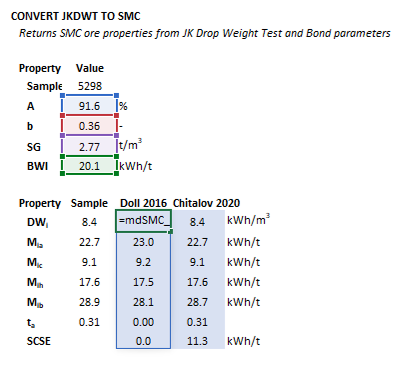Comminution Circuit Specific Energy (Morrell)
Description
This article describes the Morrell method for estimating the specific energy of comminution circuits (Morrell et al., 2016).[1]
The Morrell method estimates the specific energy required to grind ore in comminution circuits, based on empirical models calibrated with laboratory test results. The method integrates ore hardness parameters from standardised testing with proposed circuit grind sizes to compute energy consumption across different equipment types.
Model theory
Comminution circuit specific energy
General equation
Tumbling mills
Coarse particle tumbling mill
Fine particle tumbling mill
Crushers
High pressure grinding rolls
Size distribution correction
Hardness parameters
Estimating P80
Estimating breakage parameters
Excel
Coarse particle tumbling mill specific energy
The coarse particle tumbling mill specific energy calculation may be invoked from the Excel formula bar with the following function call:
=mdSMC_Wa(K1 as Double, Mia as Double, x1 as Double, Optional returnCalcs as Boolean = false)
Invoking the function with no arguments will print Help text associated with the model, including a link to this page.
The input parameters and calculation results are defined below in matrix notation, along with an example image showing the selection of the same cells and arrays in the Excel interface:
|
| ||||
Fine particle tumbling mill specific energy
The fine particle tumbling mill specific energy calculation may be invoked from the Excel formula bar with the following function call:
=mdSMC_Wb(Mib as Double, x3 as Double, Optional returnCalcs as Boolean = false)
Invoking the function with no arguments will print Help text associated with the model, including a link to this page.
The input parameters and calculation results are defined below in matrix notation, along with an example image showing the selection of the same cells and arrays in the Excel interface:
|
| ||||
Conventional crushing specific energy
The conventional crushing specific energy calculation may be invoked from the Excel formula bar with the following function call:
=mdSMC_Wc(K2 as Double, Mic as Double, x1 as Double, x2 as Double, Optional returnCalcs as Boolean = false)
Invoking the function with no arguments will print Help text associated with the model, including a link to this page.
The input parameters and calculation results are defined below in matrix notation, along with an example image showing the selection of the same cells and arrays in the Excel interface:
|
| ||||
HPGR specific energy
The HPGR specific energy calculation may be invoked from the Excel formula bar with the following function call:
=mdSMC_Wh(K3 as Double, Mih as Double, x1 as Double, x2 as Double, Optional returnCalcs as Boolean = false)
Invoking the function with no arguments will print Help text associated with the model, including a link to this page.
The input parameters and calculation results are defined below in matrix notation, along with an example image showing the selection of the same cells and arrays in the Excel interface:
|
| ||||
Specific energy correction for size distribution
The specific energy correction for size distribution calculation may be invoked from the Excel formula bar with the following function call:
=mdSMC_Ws(Mia as Double, x1 as Double, x2 as Double, Optional returnCalcs as Boolean = false)
Invoking the function with no arguments will print Help text associated with the model, including a link to this page.
The input parameters and calculation results are defined below in matrix notation, along with an example image showing the selection of the same cells and arrays in the Excel interface:
|
| ||||
General comminution specific energy
The general comminution specific energy calculation may be invoked from the Excel formula bar with the following function call:
=mdSMC_W(K as Double, Mi as Double, x1 as Double, x2 as Double, Optional returnCalcs as Boolean = false)
Invoking the function with no arguments will print Help text associated with the model, including a link to this page.
The input parameters and calculation results are defined below in matrix notation, along with an example image showing the selection of the same cells and arrays in the Excel interface:
|
| ||||
Calculating P80
The P80 calculation may be invoked from the Excel formula bar with the following function call:
=mdSMC_P80(K as Double, Mi as Double, F80 as Double, W as Double, Optional returnCalcs as Boolean = false)
Invoking the function with no arguments will print Help text associated with the model, including a link to this page.
The input parameters and calculation results are defined below in matrix notation, along with an example image showing the selection of the same cells and arrays in the Excel interface:
|
| ||||
Estimating breakage parameters
The breakage parameter estimation may be invoked from the Excel formula bar with the following function call:
=mdSMC_AbToSMC(A as Double, b as Double, SG as Double, BWI as Double, Optional conversionMethod as Integer = 0)
Invoking the function with no arguments will print Help text associated with the model, including a link to this page.
The input parameters and calculation results are defined below in matrix notation, along with an example image showing the selection of the same cells and arrays in the Excel interface:
|
| ||||
See also
External links
- Global Mining Guidelines Group - The Morrell method for determining comminution circuit specific energy and assessing energy utilization efficiency of existing circuits
- SMC Testing - The SCSE Parameter
- SMC Testing - Reporting JKDWT and SMC Results
References
- ↑ Morrell, S., Daniel, M. and Burke, J., 2016. Morrell method for determining comminution circuit specific energy and assessing energy utilization efficiency of existing circuits. Global Mining Standards and Guidelines Group: Ormstown, QC, Canada.
![{\displaystyle {\begin{aligned}K1&={\big [}K_{1}{\big ]}\\{\mathit {Mia}}&={\big [}M_{\rm {ia}}{\text{ (kWh/t)}}{\big ]}\\x1&={\big [}x_{1}{\text{ (}}\mu {\text{m)}}{\big ]}\\{\mathit {returnCalcs}}&={\big [}({\text{True / False)}}{\big ]}\end{aligned}}}](https://wikimedia.org/api/rest_v1/media/math/render/svg/2100f4f744eff46ff9d35d363a77c200e2616653)









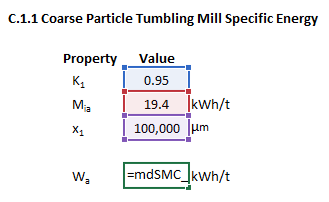

![{\displaystyle {\begin{aligned}{\mathit {Mib}}&={\big [}M_{\rm {ib}}{\text{ (kWh/t)}}{\big ]}\\x3&={\big [}x_{3}{\text{ (}}\mu {\text{m)}}{\big ]}\\{\mathit {returnCalcs}}&={\big [}({\text{True / False)}}{\big ]}\end{aligned}}}](https://wikimedia.org/api/rest_v1/media/math/render/svg/a4b60dc5c3de0dbd9604caf116e413e8361ea633)



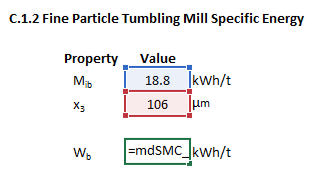
![{\displaystyle {\begin{aligned}K2&={\big [}K_{2}{\big ]}\\{\mathit {Mic}}&={\big [}M_{\rm {ic}}{\text{ (kWh/t)}}{\big ]}\\x1&={\big [}x_{1}{\text{ (}}\mu {\text{m)}}{\big ]}\\x2&={\big [}x_{2}{\text{ (}}\mu {\text{m)}}{\big ]}\\{\mathit {returnCalcs}}&={\big [}({\text{True / False)}}{\big ]}\end{aligned}}}](https://wikimedia.org/api/rest_v1/media/math/render/svg/d69a0378da1e6bc841d1cc9193e4337bd7d40f45)






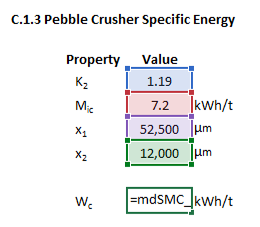
![{\displaystyle {\begin{aligned}K3&={\big [}K_{3}{\big ]}\\{\mathit {Mih}}&={\big [}M_{\rm {ih}}{\text{ (kWh/t)}}{\big ]}\\x1&={\big [}x_{1}{\text{ (}}\mu {\text{m)}}{\big ]}\\x2&={\big [}x_{2}{\text{ (}}\mu {\text{m)}}{\big ]}\\{\mathit {returnCalcs}}&={\big [}({\text{True / False)}}{\big ]}\end{aligned}}}](https://wikimedia.org/api/rest_v1/media/math/render/svg/f9fa80b4753d10b9c79437011cb9f6fbbe0b027e)





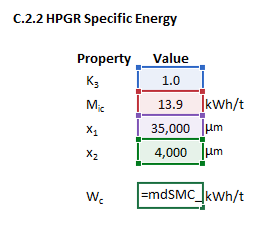
![{\displaystyle {\begin{aligned}{\mathit {Mia}}&={\big [}M_{\rm {ia}}{\text{ (kWh/t)}}{\big ]}\\x1&={\big [}x_{1}{\text{ (}}\mu {\text{m)}}{\big ]}\\x2&={\big [}x_{2}{\text{ (}}\mu {\text{m)}}{\big ]}\\{\mathit {returnCalcs}}&={\big [}({\text{True / False)}}{\big ]}\end{aligned}}}](https://wikimedia.org/api/rest_v1/media/math/render/svg/9eaf9b4d6ce9b2729daee36b15fedc963f6d8b02)

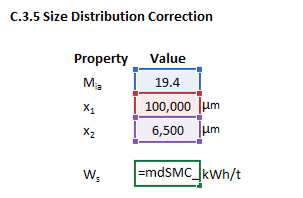
![{\displaystyle {\begin{aligned}K&={\big [}K{\big ]}\\{\mathit {Mi}}&={\big [}M_{\rm {i}}{\text{ (kWh/t)}}{\big ]}\\x1&={\big [}x_{1}{\text{ (}}\mu {\text{m)}}{\big ]}\\x2&={\big [}x_{2}{\text{ (}}\mu {\text{m)}}{\big ]}\\{\mathit {returnCalcs}}&={\big [}({\text{True / False)}}{\big ]}\end{aligned}}}](https://wikimedia.org/api/rest_v1/media/math/render/svg/a9c9433079ff72a48e52c1857ba7cccec261866c)


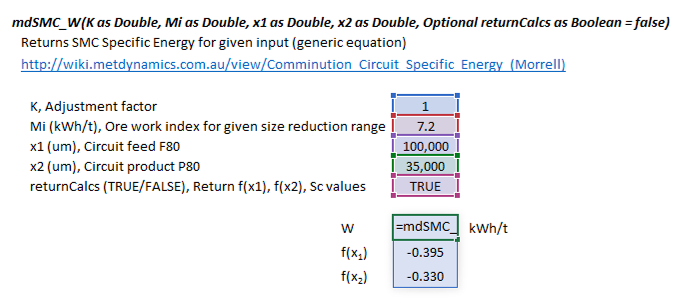

![{\displaystyle {\begin{aligned}K&={\big [}K{\big ]}\\{\mathit {Mi}}&={\big [}M_{\rm {i}}{\text{ (kWh/t)}}{\big ]}\\F80&={\big [}F_{80}{\text{ (}}\mu {\text{m)}}{\big ]}\\W&={\big [}W{\text{ (kWh/t)}}{\big ]}\\{\mathit {returnCalcs}}&={\big [}({\text{True / False)}}{\big ]}\end{aligned}}}](https://wikimedia.org/api/rest_v1/media/math/render/svg/6405424c725f31c8bb38f3fbec0ad264fb75bb36)




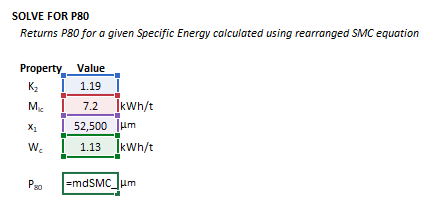
![{\displaystyle {\begin{aligned}A&={\big [}A{\text{ (}}\%{\text{)}}{\big ]}\\b&={\big [}b{\big ]}\\{\mathit {SG}}&={\big [}\rho _{\rm {S}}{\text{ (t/m}}^{3}{\text{)}}{\big ]}\\{\mathit {BWI}}&={\big [}{\mathit {Wi}}_{\rm {BM}}{\text{ (kWh/t}}{\big ]}\\{\mathit {conversionMethod}}&={\big [}{\text{0 (Doll) or 1 (Chitalov)}}{\big ]}\end{aligned}}}](https://wikimedia.org/api/rest_v1/media/math/render/svg/38bcc1ea873c0bd266c95a4d7cc840970bb8779e)









